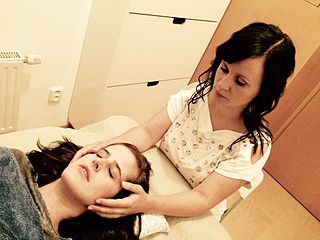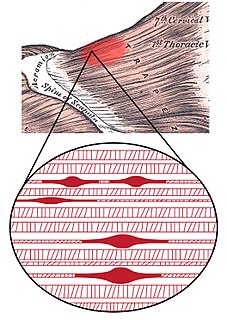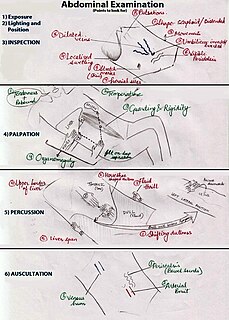Related Research Articles

Chiropractic is a form of alternative medicine concerned with the diagnosis, treatment and prevention of mechanical disorders of the musculoskeletal system, especially of the spine. It has esoteric origins and is based on several pseudoscientific ideas.

Temporomandibular joint dysfunction is an umbrella term covering pain and dysfunction of the muscles of mastication and the temporomandibular joints. The most important feature is pain, followed by restricted mandibular movement, and noises from the temporomandibular joints (TMJ) during jaw movement. Although TMD is not life-threatening, it can be detrimental to quality of life; this is because the symptoms can become chronic and difficult to manage.

Massage is the manipulation of the body's soft tissues. Massage techniques are commonly applied with hands, fingers, elbows, knees, forearms, feet, or a device. The purpose of massage is generally for the treatment of body stress or pain. In European countries, a person professionally trained to give massages is traditionally known as a masseur (male) or masseuse (female). In the United States, these individuals are often referred to as massage therapists, because they must be certified and licensed as "licensed massage therapists".

Osteopathy is a type of alternative medicine that emphasizes physical manipulation of the body's muscle tissue and bones. Practitioners of osteopathy are referred to as osteopaths.

Craniosacral therapy (CST) or cranial osteopathy is a form of alternative therapy that uses gentle touch to palpate the synarthrodial joints of the cranium. CST is a pseudoscience, and its practice has been characterized as quackery. It is based on fundamental misconceptions about the physiology of the human skull and is promoted as a cure-all for a variety of health conditions.
Manual therapy, or manipulative therapy, is a physical treatment primarily used by physical therapists, physiotherapists, occupational therapists to treat musculoskeletal pain and disability; it mostly includes kneading and manipulation of muscles, joint mobilization and joint manipulation. It is also used by Rolfers, massage therapists, athletic trainers, osteopaths, and physicians.

Myofascial trigger points (MTrPs), also known as trigger points, are described as hyperirritable spots in the skeletal muscle. They are associated with palpable nodules in taut bands of muscle fibers. They are a topic of ongoing controversy, as there is limited data to inform a scientific understanding of the phenomenon. Accordingly, a formal acceptance of myofascial "knots" as an identifiable source of pain is more common among bodyworkers, physical therapists, chiropractors, and osteopathic practitioners. Nonetheless, the concept of trigger points provides a framework which may be used to help address certain musculoskeletal pain.

Spinal adjustment and chiropractic adjustment are terms used by chiropractors to describe their approaches to spinal manipulation, as well as some osteopaths, who use the term adjustment. Despite anecdotal success, there is no scientific evidence that spinal adjustment is effective against disease.

Spinal manipulation is an intervention performed on spinal articulations, synovial joints, which is asserted to be therapeutic. These articulations in the spine that are amenable to spinal manipulative therapy include the z-joints, the atlanto-occipital, atlanto-axial, lumbosacral, sacroiliac, costotransverse and costovertebral joints. National guidelines come to different conclusions with respect to spinal manipulation with some not recommending it, and others recommending a short course in those who do not improve with other treatments.

An abdominal examination is a portion of the physical examination which a physician or nurse uses to clinically observe the abdomen of a patient for signs of disease. The physical examination typically occurs after a thorough medical history is taken, that is, after the physician asks the patient the course of their symptoms. The abdominal examination is conventionally split into four different stages: first, inspection of the patient and the visible characteristics of their abdomen. Auscultation (listening) of the abdomen with a stethoscope. Palpation of the patient's abdomen. Finally, percussion (tapping) of the patient's abdomen and abdominal organs. Depending on the need to test for specific diseases such as ascites, special tests may be performed as a part of the physical examination. An abdominal examination may be performed because the physician suspects a disease of the organs inside the abdominal cavity, or simply as a part of a complete physical examination for other conditions. In a complete physical examination, the abdominal exam classically follows the respiratory examination and cardiovascular examination.
Myofascial release is an alternative medicine therapy claimed to be useful for treating skeletal muscle immobility and pain by relaxing contracted muscles, improving blood and lymphatic circulation, and stimulating the stretch reflex in muscles.
Myofascial pain syndrome (MPS), also known as chronic myofascial pain (CMP), is a syndrome characterized by chronic pain in multiple myofascial trigger points ("knots") and fascial constrictions. It can appear in any body part. Symptoms of a myofascial trigger points include: focal point tenderness, reproduction of pain upon trigger point palpation, hardening of the muscle upon trigger point palpation, pseudo-weakness of the involved muscle, referred pain, and limited range of motion following approximately 5 seconds of sustained trigger point pressure.
Muscle Energy Techniques (METs) describes a broad class of manual therapy techniques directed at improving musculoskeletal function or joint function, and improving pain. METs are commonly used by manual therapists, physical therapists, occupational therapist, chiropractors, athletic trainers, osteopathic physicians, and massage therapists. Muscle energy requires the patient to actively use his or her muscles on request to aid in treatment. Muscle energy techniques are used to treat somatic dysfunction, especially decreased range of motion, muscular hypertonicity, and pain.
Dry needling, also known as trigger point dry needling and intramuscular stimulation, is a pseudoscientific technique used by various healthcare practitioners, including physical therapists, physicians, and chiropractors, among others. Acupuncturists usually maintain that dry needling is adapted from acupuncture, but others consider dry needling as a variation of trigger point injections. It involves the use of either solid filiform needles or hollow-core hypodermic needles for therapy of muscle pain, including pain related to myofascial pain syndrome. Dry needling is mainly used to treat myofascial trigger points, but it is also used to target connective tissue, neural ailments, and muscular ailments. The American Physical Therapy Association defines dry needling as a technique used to treat dysfunction of skeletal muscle and connective tissue, minimize pain, and improve or regulate structural or functional damage.
Balanced ligamentous tension is both an indirect and direct technique used in osteopathic manipulative medicine.
Chiropractors use their version of spinal manipulation as their primary treatment method, with non-chiropractic use of spinal manipulation gaining more study and attention in mainstream medicine in the 1980s. There is no evidence that chiropractic spinal adjustments are effective for any medical condition, with the possible exception of treatment for lower back pain. The safety of manipulation, particularly on the cervical spine has been debated. Adverse results, including strokes and deaths, are rare.
Myotherapy is a form of muscle therapy which focuses on the assessment, treatment and rehabilitation of musculoskeletal pain and associated pathologies. The term myotherapy was originally coined by Bonnie Prudden to describe a specific type of trigger point therapy which she developed in the 1970s based on the earlier work of Travell and Simons who researched the cause and treatment of pain arising from myofascial trigger points. While based on rational principles, there is little scientific research regarding the efficacy of this therapy, so it remains controversial within the medical and academic disciplines.
Articulatory technique is a type of Osteopathic Manipulative Treatment (OMT) performed by osteopathic practitioners and U.S. trained osteopathic physicians. The physician uses low velocity and moderate to high amplitude forces to carry a dysfunctional joint through its full range of motion, with the therapeutic goal of increasing range of motion. It is a technique that involves repeatedly taking a restricted joint into and out of its barrier to reduce a restriction.
Hara. In the Japanese medical tradition and in Japanese martial arts traditions, the word Hara is used as a technical term for a specific area (physical/anatomical) or energy field (physiological/energetic) of the body. An alternative Japanese reading of the character is Hufu, the Chinese reading is Fu.
Dentomandibular sensorimotor dysfunction (DMSD) is a medical condition involving the mandible, upper three cervical (neck) vertebrae, and the surrounding muscle and nerve areas.
References
- ↑ Wong, CK; Abraham, T; Karimi, P; Ow-Wing, C (Apr 2014). "Strain counterstrain technique to decrease tender point palpation pain compared to control conditions: a systematic review with meta-analysis". Journal of Bodywork and Movement Therapies. 18 (2): 165. doi:10.1016/j.jbmt.2013.09.010. PMID 24725782.
- ↑ Tuckey, Brian; Shah, Jay; Tandon, Hannah (2017). "A New Rationale and Treatment Model for Neuromuscular Tender Points".
{{cite journal}}: Cite journal requires|journal=(help) - ↑ DiGiovanna, Eileen; Stanley Schiowitz; Dennis J. Dowling (2005) [1991]. "Counterstrain (Chapter 14)". An Osteopathic Approach to Diagnosis and Treatment (Third ed.). Philadelphia, PA: Lippincott Williams & Wilkins. pp. 86–88.
- 1 2 Chaitow, Leon (2014). Fascial Dysfunction: Manual Therapy Approaches, Chapter 16 - Positional Release Techniques. Pencaitland, East Lothian: Handspring Publishing. pp. 205–213. ISBN 978-1-909141-10-0.
- ↑ "Glossary of Osteopathic Terminology" (PDF). American Association of Colleges of Osteopathic Medicine. April 2009. p. 28. Retrieved 25 August 2012.
- ↑ Wong, CK (2012). "Strain counterstrain: current concepts and clinical evidence". Manual Therapy. 17 (1): 2–8. doi:10.1016/j.math.2011.10.001. PMID 22030379.
- 1 2 Kusunose, Randall (1992). Rational Manual Therapies. Williams & Wilkins. pp. 324–325. ISBN 978-0683004205.